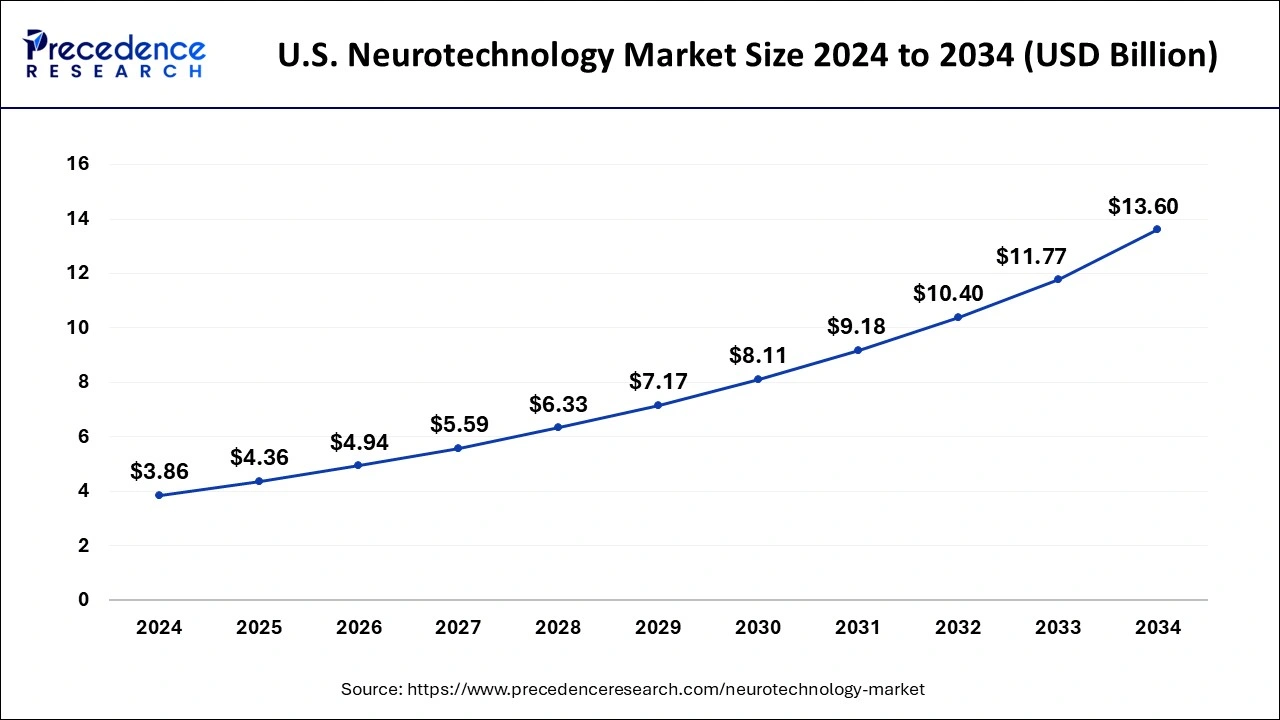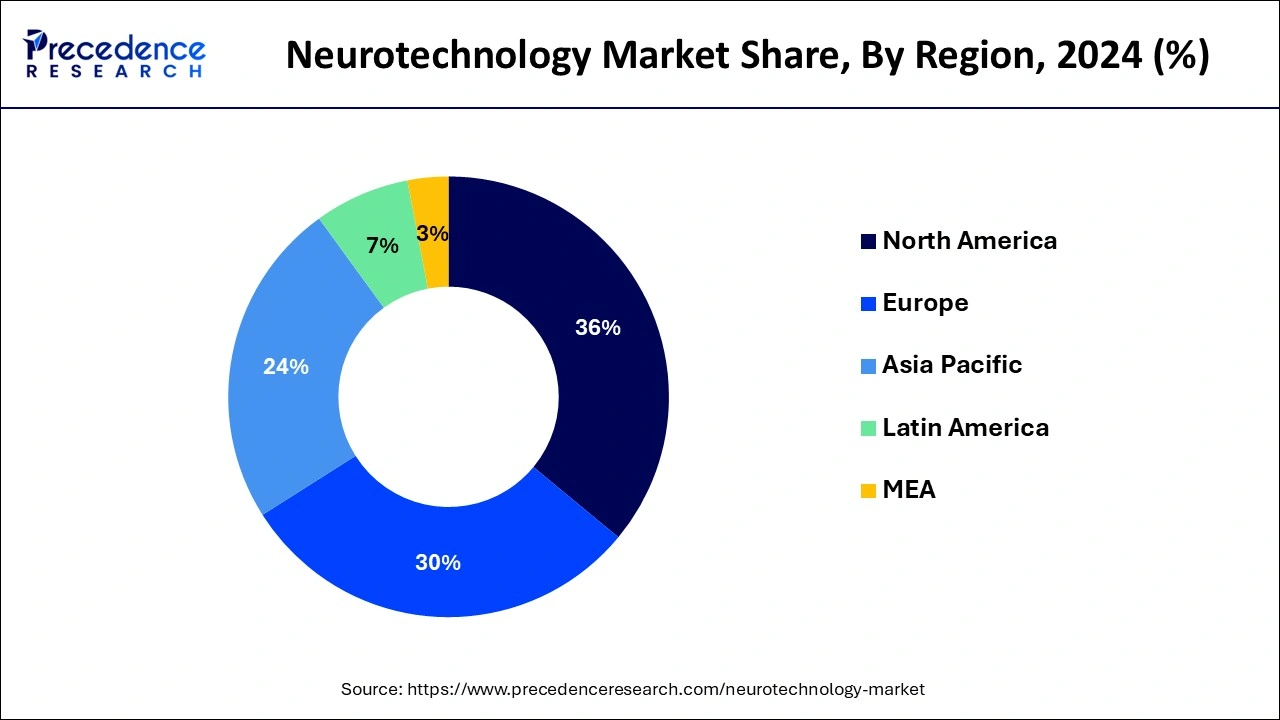Neurotechnology Market Size and Forecast 2025 to 2034
The global neurotechnology market size was estimated at USD 15.30 billion in 2024 and is anticipated to reach around USD 52.86 billion by 2034, expanding at a CAGR of 13.19% from 2025 to 2034. The growth of the neurotechnology market is driven by the rising prevalence of neurological disorders across the globe.

Neurotechnology Market Key Takeaways
- North America dominated the global market with the largest market share of 36% in 2024.
- By product type, the neurostimulation segment contributed the highest share in 2024.
- By conditions, the pain treatment segment has held a major market share in 2024.
- By end-use, the hospital segment recorded the significant market share in 2024.
Impact of AI on the Neurotechnology Market
Integrating AI algorithms in neurostimulation devices helps analyze and process brain signals and convert them into commands, which enable patients with paralysis to control wheelchairs and prosthetic limbs. AI also analyzes brain imaging, which helps to develop personalized treatment plans and optimize patient care. Furthermore, AI also has the ability to improve cognitive abilities, speed up learning processes, and enhance memory.
U.S. Neurotechnology Market Size and Growth 2025 to 2034
The U.S. neurotechnology market size was evaluated at USD 3.86 billion in 2024 and is predicted to be worth around USD 13.60 billion by 2034, rising at a CAGR of 13.42 % from 2025 to 2034.

The neurotechnology industry in North America is expected to expand significantly in the upcoming years because of the region's increasing technological innovation and advanced healthcare settings in neurotech equipment. The market is changing in favor of more knowledge and investment in diagnosing and treating neurological diseases at various primary care facilities.

The existence of different market participants devoted to creating cutting-edge neurotech devices to enhance patient monitoring will aid market expansion. The working of significant industry players should help the region's growth in the upcoming years to increase public knowledge of neurotech devices through marketing and promotion.
Market Overview
Neurotechnology has a promising future in altering human nature when employed fundamentally. Existing neurotechnology-based devices describe how the brain works, but further study is required before they can be fully implemented. For accurate neurological ailment diagnosis and prognosis, researchers can connect to brain activity and understand people's lifestyle patterns and personalities owing to the application of neurotechnology in medical science. During the projected 2025–2034, each of these variables may present the neurotechnology market with new growth opportunities.
Neurotechnology is defined as technical development that enables the investigation and treatment of neurological processes. The nervous system controls almost every aspect of human biology and is essential for experiencing the environment. Any interruption of a procedure could be dangerous to a person. Therefore, neurological research and treatment are crucial for curing these patients' symptoms and understanding the complex ways the brain works.
Growth Factors
- Rising government funding in neurotechnology research and development to foster innovative product development further fuel market growth.
- The growing aging population is likely to contribute to market expansion since older people are more prone to neurological diseases.
- The growing awareness about neurological diseases and the availability of therapeutics further bolster the growth of the market.
- An increase in traffic accidents contributes to the market expansion.
Neurotechnology Market Scope
| Report Coverage | Details |
| Market Size in 2025 | USD 17.32 Billion |
| Market Size by 2034 | USD 52.86 Billion |
| Growth Rate from 2025 to 2034 | CAGR of 13.19% |
| Largest Market | North America |
| Base Year | 2024 |
| Forecast Period | 2025 to 2034 |
| Segments Covered | By Product Type, By Conditions, By End-Use |
| Regions Covered | North America, Europe, Asia-Pacific, Latin America and Middle East & Africa |
Market Dynamics
Driver
With the growing prevalence of chronic diseases like hypertension and cardiovascular diseases, the prevalence of neurological disorders is rising. Chronic conditions often lead to mood disorders, memory loss, and cognitive decline. This further affects the nervous system, thus boosting the demand for neuro devices to manage conditions. Moreover, the increasing number of cases of neurological diseases is driving the growth of the market. According to the WHO, neurological disorders are the leading cause of disability. Every year, approximately 1 billion people, which means nearly one in six of the world's population, suffer from neurological disorders, such as Alzheimer's and Parkinson's disease.
Restraint
Despite neuro devices being effective in treating neurological disorders, the development and manufacturing processes associated with these devices require substantial investments, which further pass on to the final product price. Thus, the high costs associated with these devices discourage healthcare providers and patients from investing in them. Additionally, the lack of awareness about the availability of neuro devices in underserved areas can limit the growth of the market.
Opportunity
Neuro implants possess significant potential for the treatment of various neurological disorders and chronic pain conditions, marking a notable opportunity for growth within the market. By directing investment into research and development focused on neuro implants, particularly for early detection and intervention of neurological disorders, stakeholders can enhance therapeutic outcomes and potentially expand market opportunities. This proactive approach could lead to breakthroughs that improve patient quality of life and increase adoption rates of neurotechnology solutions in clinical settings.
Product Type Insights
The neurostimulation segment contributed the highest share in 2024 in terms of product type as it assists in treating several illnesses like epilepsy, movement problems, chronic pain, and Parkinson's disease; neurostimulation devices administer electric impulses to particular parts of the brain, nervous system, or peripheral nervous system. They are biocompatible, programmable medical devices. Future growth for neurostimulation devices is being driven by an increase in the incidence of lifestyle diseases, including chronic pain and depression, as well as a rise in the number of neurological illnesses and investment in neurological technology and development.
ConditionsInsights
Based on conditions, in the upcoming years, the neurotech devices market share for pain treatment will likely increase significantly. The main factors influencing the market for this sector are the increased prevalence of chronic pain disorders and the rising demand for pain management products due to their significant therapeutic advantages. During the projection period, the sector is anticipated to grow the fastest. Diseases like disc surgical procedures, discomfort, pain in the knees or other muscles, and chronic pain are included in this section.
End-Use Insights
The hospital segment recorded the significant market share in 2024, according to the neurotechnology market forecast. This expansion can be linked to increased public and private investment in healthcare settings to create established healthcare facilities. Neuromodulation, an invasive method that requires surgical implantation of an electrode in the brain area affected, is the most typical use for adaptive neurotech devices in hospitals. However, because of these potential benefits, the market sector is anticipated to expand over the next few years. Additionally, hospitals have highly qualified staff, specialized equipment, and state-of-the-art neurotech gadgets to perform a variety of brain diagnoses and treatments.
Neurotechnology Market Companies

- General Electric Company
- Siemens Healthcare Private Limited
- Shimadzu Corporation
- Koninklijke Philips N.V.
- Hitachi Medical Corporation
- Elekta AB
- Toshiba Medical Systems Corporation
- Tristan Technologies, Inc.
Recent Developments
- In September 2024, Neurable Inc. launched the MW75 Neuro, smart headphones integrated with Neurable's brain-computer interface (BCI) technology to help users gain deeper insights into their cognitive health, manage burnout, and enhance daily performance.
- In June 2024, Canadian neurotechnology company Zentrela announced the EU launch of its Cognalyzer product, which is a portable device that can scan brainwaves and leverage AI to quantify if a person is experiencing the effects of cannabis.
Segment Covered in the Report
By Product Type
- Neurostimulation
- Deep Brain Stimulator
- Spinal Cord Stimulator
- Gastric Electric Stimulator
- Vagus Nerve Stimulator
- Sacral Nerve Stimulator
- Transcutaneous Electrical Nerve Stimulation (TENS)
- Others
- Neurosensing
- Neuroprostheses
- Neurorehabilitation
By Conditions
- Cognitive Disorders
- Pain Treatment
- Urinary and Fecal Incontinence
- Epilepsy
- Parkinson's disease
- Hearing Conditions
- Sleep Disorder
- Depression
- Others
By End-Use
- Ambulatory surgical centers
- Hospitals
- Homecare facilities
- Others
By Geography
- North America
- Europe
- Asia-Pacific
- Latin America
- Middle East & Africa (MEA)
For inquiries regarding discounts, bulk purchases, or customization requests, please contact us at sales@precedenceresearch.com
Frequently Asked Questions
Ask For Sample
No cookie-cutter, only authentic analysis – take the 1st step to become a Precedence Research client
 sales@precedenceresearch.com
sales@precedenceresearch.com
 +1 804-441-9344
+1 804-441-9344